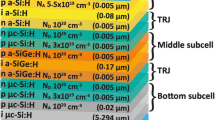Abstract
Bifacial solar cells that maximize the energy output per a square meter have become a new fashion in the field of photovoltaic cells. However, the application of thin-film material on bifacial solar cells, viz., thin-film amorphous hydrogenated silicon (a-Si:H), is extremely rare. Therefore, this paper presents the optimization and influence of the band gap, thickness and doping on the performance of a glass/glass thin-film a-Si:H (n-i-p) bifacial solar cell, using a computer-aided simulation tool, Automat for simulation of hetero-structures (AFORS-HET). It is worth mentioning that the thickness and the band gap of the i-layer are the key parameters in achieving higher efficiency and hence it has to be handled carefully during the fabrication process. Furthermore, an efficient thin-film a-Si:H bifacial solar cell requires thinner and heavily doped n and p emitter layers. On the other hand, the band gap of the p-layer showed a dramatic reduction of the efficiency at 2.3 eV. Moreover, a high bifaciality factor of more than 92% is attained, and top efficiency of 10.9% is revealed under p side illumination. These optimizations demonstrate significant enhancements of the recent experimental work on thin-film a-Si:H bifacial solar cells and would also be useful for future experimental investigations on an efficient a-Si:H thin-film bifacial solar cell.
Similar content being viewed by others
References
S. Sharma and J.A. Aragón Correa, Corporate Environmental Strategy and Competitive Advantage (Cheltenham: Edward Elgar Publishing Ltd, 2005).
P. Gadonneix, N. Marie-José, and D.K. Younghoon, World Energy Scenarios Composing Energy Futures to 2050, https://www.worldenergy.org/publications/2013/world-energy-scenarios-composing-energy-futures-to-2050/. Accessed 07 May, 2017.
A. Goetzberger, C. Hebling, and H.W. Schock, Mater. Sci. Eng. R 40, 1 (2003).
H. Mori, mM/ w -RADIATION ENERGY TRANSDUCING DEVICE, http://www.google.tl/patents/US3173378, 1966. Accessed 07 May, 2017.
A. Luque, J. M. Ruiz, A. Cuevas, J. Eguren, and M. G. Agost, in Photovolt. Sol. Energy Conf. (1978), pp. 269–277.
L. Kreinin, N. Bordin, A. Karsenty, A. Drori, and N. Eisenberg, in 26th Eur. Photovolt. Sol. Energy Conf. Exhib. Hambourg, Allemagne (2011), pp. 3140–3143.
A. Cuevas, A. Luque, J. Eguren, and J. del Alamo, Sol. Energy 29, 419 (1982).
A. Hubner, A. Aberle, and R. Hezel, in Conf. Rec. Twenty Sixth IEEE Photovolt. Spec. Conf. (1997), pp. 223–226.
I. Araki, M. Tatsunokuchi, H. Nakahara, and T. Tomita, Sol. Energy Mater. Sol. Cells, 911 (2009).
R. Auer, B. Mayregger, and R. Hezel, in I lth Symposium on Photovoltaic Solar Energy (1996), pp. 100–104.
P.G. Carey, R.C. Aceves, and N.J. Colella, in Conference Record of the Twenty Fourth. IEEE Photovoltaic Specialists Conference (1994), pp. 1963–1969.
L. Prat,. R. Alcubill, E. Blasco, E. Garcia, J. Calderer, X. Correig, and L. Castañer, Sol. Cells, 303 (1990).
International Technology Roadmap for Photovoltaic (ITRPV). Sixth edition, http://www.itrpv.net/Reports/Downloads/2015/. Accessed 05.August.2017.
N. Dwivedi, S. Kumar, A. Bisht, K. Patel, and S. Sudhakar, Sol. Energy 88, 31 (2013).
K. Lam, B. Chris, L. Chris, E. Christoph, H. Zhiquan, X. Zheng, J.B. Heng, F. Jianming, K. Bob, C. Yongkee, W. Wei, W. Zhigang, and R. Anand, IEEE J. Photovoltaics, 82 (2015).
K. Krau, F. Fertig, J. Greulich, S. Rein, R. Preu, and R. Preu, Prog. Photovoltaics Res. Appl. 24, 800–817 (2016).
J. Arumughan, R. Kopecek, T. Pernau, T. Buck, P. Fath, and K. Peter, in 2006 IEEE 4th World Conference on Photovoltaic Energy Conference (2006), pp. 1103–1106.
F. Fertig, K. Krau, J. Greulich, F. Clement, D. Biro, R. Preu, and S. Rein, Energy Procedia, 416 (2014).
H. Ohtsuka, M. Sakamoto, K. Tsutsui, T. Uematsu, and Y. Yazawa, Prog. Photovolt: Res. Appl. 9, 1 (2001).
K. von, M. N. Reininghaus, and C. Feser, in Conference PVSEC (2014), pp. 461–468.
A. Froitzheim, R. Stangl, L. Elstner, M. Schmidt, and W. Fuhs, in Conference Record of the Twenty-Ninth IEEE Photovoltaic Specialists Conference (2002), pp. 1238–1241.
J. Frank, M. Rüdiger, S. Fischer, J.C. Goldschmidt, and M. Hermle, Energy Procedia 27, 300 (2012).
M. Tucci, M. Della Noce, E. Bobeico, F. Roca, G. De Cesare, and F. Palma, Thin Solid Films 451, 355 (2004).
Author information
Authors and Affiliations
Corresponding author
Rights and permissions
About this article
Cite this article
Berrian, D., Fathi, M. & Kechouane, M. Numerical Optimization of a Bifacial Bi-Glass Thin-Film a-Si:H Solar Cell for Higher Conversion Efficiency. J. Electron. Mater. 47, 1140–1150 (2018). https://doi.org/10.1007/s11664-017-5828-7
Received:
Accepted:
Published:
Issue Date:
DOI: https://doi.org/10.1007/s11664-017-5828-7




